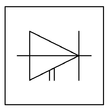Thyristor switch
A thyristor switch is an electronic circuit which consists of one or more thyristors and is used as a contactless electrical switch for switching electrical consumers such as electric motors on and off . A distinction is made between thyristor switches for direct current and alternating current .
variants
Direct current
For direct current , a thyristor switch, as shown in the adjacent circuit diagram, consists of the main thyristor T H , the quenching thyristor T L , as well as the capacitor C and the coil L. Together with a free-wheeling diode , this is connected in parallel to the consumer (motor M), the result is a DC chopper as shown in the circuit diagram.
The function of the circuit:
- To switch on the consumer (motor M), the extinguishing thyristor T L is first ignited . A charging current of the capacitor flows from the battery via the capacitor, the quenching thyristor and the motor M.
- After that, the ignition of the main thyristor T follows H . A load current flows through the thyristor and the motor. In addition, the capacitor discharges through T H , D and L. The capacitor C is recharged. The consumer is now permanently switched on, the motor M is running.
- The shutdown is performed by igniting the quenching thyristor T L . The point of the second charge stored in the capacitor C now like about T L and T H out. The load current in T H is reduced by the current from the capacitor and lowered below the holding current of the main thyristor, whereby the load current is interrupted and the main thyristor T H blocks permanently. The cycle can then start again at the first point.
The pulse duty factor can be determined via the time relationship between the switching intervals of T H and T L. The motor voltage can then be controlled through a rapid sequence of on and off states in a specific range.
Alternating current
A thyristor switch for alternating current, also known as an electronic contactor , consists of two anti-parallel connected thyristors or a triac , with ignition always taking place when the alternating voltage crosses zero . A quenching circuit as in the DC circuit is not required. As soon as no more ignition pulses are generated, the thyristor switch extinguishes at the next zero crossing of the alternating current. Several thyristor switches for alternating current can be connected together to form a thyristor switch for three-phase current and controlled together.
literature
- Valentin Crastan : Electrical energy supply 2 . 3. Edition. Springer, 2012, ISBN 978-3-642-19855-7 .

